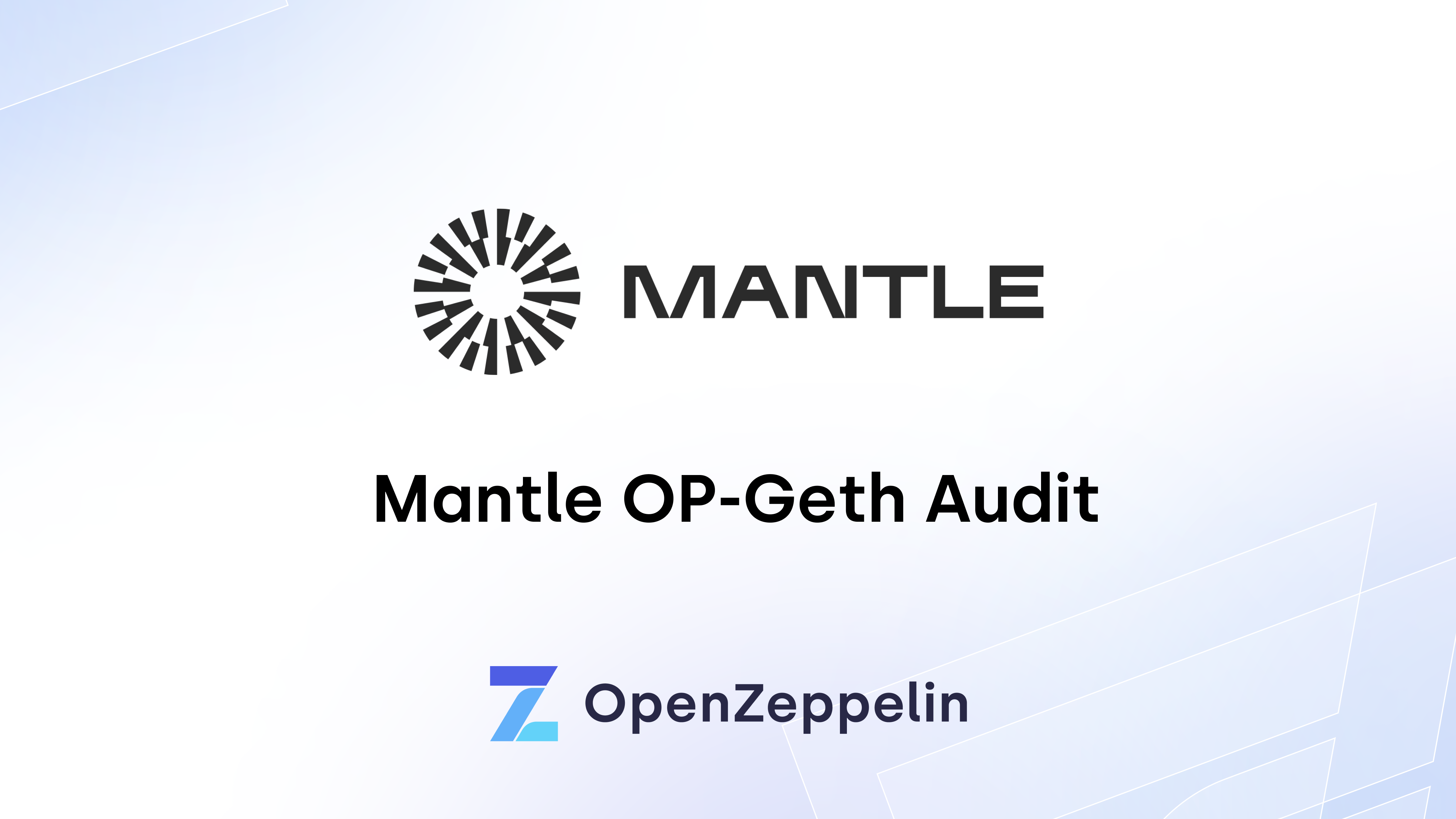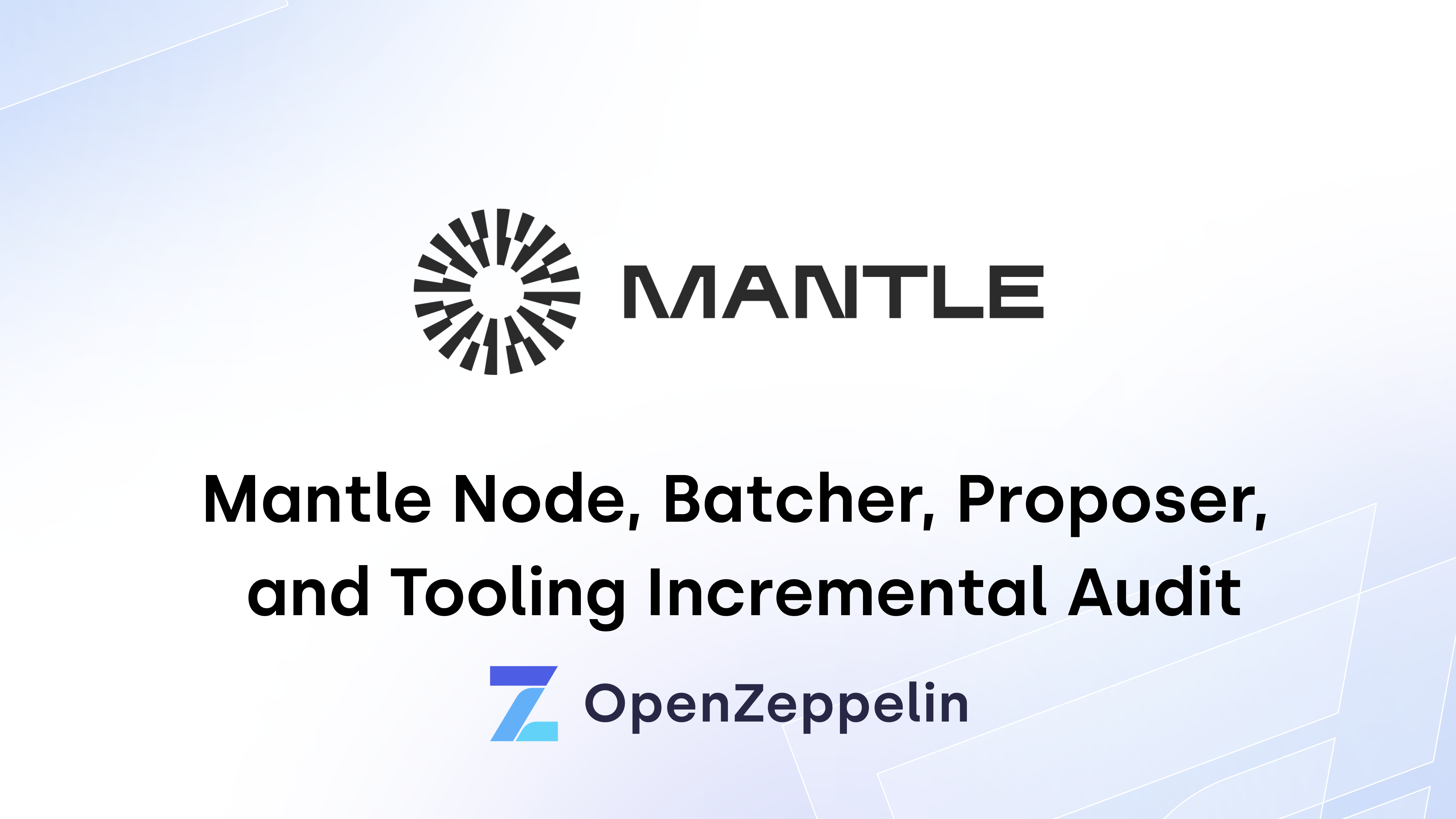November 1st, 2022
This security assessment was prepared by OpenZeppelin.
Table of Contents
Summary
The Origin Protocol team asked us to review and audit several additions to their Origin Dollar smart contracts. Below we present our results.
- Type
- DeFi – Rebasing stablecoin
- Timeline
- From 2022-10-03
- To 2022-10-14
- Languages
- Solidity
- Total Issues
- 14 (9 resolved, 1 partially resolved)
- Critical Severity Issues
- 0 (0 resolved)
- High Severity Issues
- 0 (0 resolved)
- Medium Severity Issues
- 1 (1 resolved)
- Low Severity Issues
- 9 (5 resolved, 1 partially resolved)
- Notes & Additional Information
- 4 (3 resolved)
Scope
We audited the OriginProtocol/origin-dollar repository at the bfe0ac8e5d7c05b9bf1021fafb25e0aed8a6ed45 commit.
In scope were the following contracts in the contracts/contracts directory:
├── strategies
│ ├── BaseConvexMetaStrategy.sol
│ ├── BaseCurveStrategy.sol
│ ├── ConvexGeneralizedMetaStrategy.sol
│ └── ConvexOUSDMetaStrategy.sol
├── utils
│ └── StableMath.sol
└── vault
└── VaultCore.sol
System overview
Origin Dollar (OUSD) is an ERC-20 compliant stablecoin backed by USDT, USDC, and DAI. Users can mint OUSD by depositing any of these assets to the system’s vault, to later be invested in different strategies, such as AAVE and Compound lending pools, or the Curve 3Pool pool. The accrued interest, fees generated and reward tokens collected from these strategies are then distributed among OUSD holders through a rebasing mechanism, increasing their overall OUSD balance. To learn more about how the system works and how strategies are managed, refer to the previous audit report.
The audited commit introduces two new strategies for generating yield: The Convex Generalized Meta Strategy and the Convex OUSD Meta Strategy. Both take advantage of the Convex Finance platform to increase the yield on stablecoin deposits in the Curve system.
In particular, depositors to the Curve 3Pool receive 3CRV tokens to represent their share of the pool. Those tokens are then deposited to Curve’s OUSD-3CRV metapool to potentially earn trading fees. Finally, the metapool LP tokens (OUSD3CRV-f) are deposited in Convex Finance to earn staking rewards. Naturally, the process is reversed when the strategies need to return the stablecoins to the vault.
The difference between the strategies is that OUSD Meta Strategy also mints new (uncirculated) OUSD to deposit into the OUSD-3CRV metapool to keep the metapool balanced (with some limits in extreme scenarios). Those funds are burned when they are withdrawn, so they should not be part of the circulating supply unless they are bought from the metapool directly. Additionally, OUSD tokens held by a contract (in this case the metapool) are non-rebasing by default, so any yield generated would not be distributed to the uncirculated tokens.
Security model and trust assumptions
Minimal modifications were made to the Origin protocol governance system. Therefore, the assumptions are nearly identical to those listed in the published Origin Governance Audit and Origin Dollar Audit reports.
Slight deviations of note include:
- The rewards are now collected from the strategies by a “harvester” address, set by the governor on a per-strategy basis. As before, the governor can set the reward tokens arbitrarily which lets them withdraw any funds held by the strategies.
- The new strategies invest funds in Curve’s OUSD-3Crv metapool and the Convex Finance Booster contract, and they are granted infinite allowance to spend the strategies’ assets. Therefore, the new strategies rely on these investment contracts to function correctly and safely.
Client-reported finding
While completing the audit fixes, the Origin team identified and alerted us to another issue.
The BaseConvexMetaStrategy contract initializes the maximum slippage when the variable is declared. This will set the variable in the implementation contract but not in the proxy contract where it is needed. The maximum slippage will default to zero, which will be excessively strict when redeeming metapool tokens and could cause the withdrawal to fail until the variable is updated.
This was fixed in commit 1c524c97ac4e70dbf09447313643a2a53e2da35d.
Findings
Here we present our findings.
Medium Severity
Implicit balances
There are several instances throughout the code base where the strategies use their token balance without validating it matches the expected value. This has two implications:
- It does not account for tokens that could be sent to the contract directly.
- It assumes the contract has received the expected number of tokens.
The most important example is both instances when the ConvexOUSDMetaStrategy attempts to burn all its OUSD tokens. This would fail if its balance exceeds the acceptable range, which could occur if someone sends OUSD directly to the strategy.
Additionally, in the interest of predictability:
- When the amount of tokens to deposit is already known, that value can be used instead of the contract’s balance. Alternatively, only the difference needs to be minted in the first place.
- When the amount of tokens to receive is already known, it can be used as the minimum withdrawal amount.
Lastly, in the interest of local reasoning and robustness, consider explicitly confirming that the Curve protocol returns the expected number of tokens, rather than assuming it respects the stated minimum thresholds.
Update: Fixed in commit 290c68fd25a1f2967324948398227684ec834597. The Curve system is still assumed to return the expected number of tokens.
Low Severity
Complicated accounting
The withdraw function of the BaseCurveStrategy determines the number of 3CRV tokens to burn by using the price to slightly overestimate the desired value, determining the corresponding amount of stablecoin, and then scaling down the LP amount linearly to match the required stablecoin value. Instead, consider directly querying the amount of LP tokens to burn with the calc_token_amount function, and then adjusting for fees. If desired, the amount could be validated with the calc_withdraw_one_coin function.
Update: Acknowledged, not resolved. The Origin team stated:
calc_token_amount does not account for curve fees. Correctly accounting for way curve fees are calculated ends up being more code than the current method.
Inconsistent reference to pToken
The BaseCurveStrategy has two mechanisms to refer to the 3CRV token: the generic mapping it inherits from InitializableAbstractStrategy and its own local variable. We believe the local variable was introduced as a simplification, because all three assets correspond to the same platform token, but it is used inconsistently. In particular:
- The
withdrawfunction equivocates between the mapping and the local variable in the event emission and balance check. - The
checkBalancefunction uses the mapping to retrieve the platform token balance but then assumes the asset is worth one third of the value. This only makes sense if there are three assets mapping to the same platform token. - There are code comments that explicitly account for the possibility that not all assets are mapped correctly.
Consider using the local variable throughout the contract and disabling the ability to set the mapping individually.
Update: Partially fixed in commit 49ee19e1d6bbc623bb88027c997658d21fe32390. Some functions (like safeApproveAllTokens) still use the mapping.
Inconsistent rebase bound
When minting OUSD tokens, there will be a rebase if the amount equals the threshold. However, when redeeming or burning tokens, the amount needs to be strictly greater than the threshold. Consider using an exclusive (or inclusive) bound throughout the code base.
Update: Fixed in commit e574b38ba22ae95302b9386d06aed980337c07bc.
Incorrect event parameter
Both emissions of the Deposit event in the BaseCurveStrategy contract use the platformAddress (after redundantly casting it to an address type) as the _pToken parameter. Consider using the pTokenAddress variable instead.
Update: Fixed in commit 381fdfaed1ed247167f4f2182a52c27ed9b8dd05.
Misleading comments
The code base contains several misleading comments:
- The
collectRewardTokensfunction of theBaseConvexMetaStrategycontract claims to send rewards to the vault, but it sends them to theharvesteraddress. - The
depositAllfunction of theBaseCurveStrategycontract does not accurately describe how all descendant contracts retrieve the 3CRV token address. - The comment explaining how much OUSD to add in the
ConvexOUSDMetaStrategystates that it could mint less OUSD if the metapool has too much, but it always adds at least as much OUSD as 3CRV. Moreover, it claims the metapool will end up balanced. However it won’t add more than twice as much OUSD (by value) than 3CRV, even if that’s necessary to balance the metapool. - The
mintForStrategyfunction of theVaultCorecontract claims that it cannot use thenonReentrantmodifier because it clashes with theBaseCurveStrategycontract’s modifier. However, the two modifiers do not interact with each other. Instead, it is thenonReentrantmodifier on theallocatefunction that would cause the conflict. - The
@paramcomment describing the_lpWithdrawfunction of theConvexOUSDMetaStrategycontract claims it is the number of Convex LP tokens to redeem, but it is the number of 3CRV tokens to retrieve.
Consider correcting these comments.
Update: Fixed in commit 4b7f103658656a16d160231f96f36ac1d4336dfd and commit d7ddbb3a2c261ed600d99bc73377de53b4859ad5.
Missing docstrings
The setMaxWithdrawalSlippage function of the BaseConvexMetaStrategy contract is missing its @param statement. Consider including it.
Update: Fixed in commit 689d527252ec78932d4bf422be3ac6b8245a777d.
Misusing safeApprove
The BaseCurveStrategy contract and the BaseConvexMetaStrategy contract provides functionality to grant addresses an infinite allowance. However, they bypass the safety mechanism in safeApprove that prevents changing the allowance between two non-zero values, which is intended to prevent front-running attacks that spend both allowances. In this case, since the intended allowance is unlimited, the possibility of front-running is irrelevant.
Nevertheless, we consider it bad practice to use a safety mechanism while bypassing its additional requirements. Consider using the standard approve function and validating that it succeeds.
Update: Acknowledged, not resolved. The Origin team stated:
We need to handle USDT’s non-standard return value (no boolean), and safeApprove provides a clean way of doing this.
Inconsistent storage gaps
When using the proxy pattern for upgrades, it is common practice to include storage gaps on parent contracts to reserve space for potential future variables. The size is typically chosen so that all contracts have the same number of variables (usually 50). However, the code base uses inconsistent sizes and does not always include a gap at all. In particular:
- The
InitializableAbstractStrategycontract reserves 98 slots, bringing the total storage usage up to 106. - The
BaseCurveStrategyhas no storage gaps. - The
BaseConvexMetaStrategycontract reserves 30 slots, bringing the total storage usage up to 39.
Consider using consistently sized storage gaps in all contracts that have not yet been deployed. For contracts that cannot be changed, because they are ancestors of live contracts in the code base, consider documenting the unusual storage size to facilitate safe upgrades.
Update: Fixed in commit e30022cd9fb7e815cb16ffd09a21c276f3980250.
Uninitialized implementations
The proxy contracts that represent the strategies should be initialized before they are used. However, it is good practice to initialize the implementation contracts as well to reduce the attack surface by preventing them from being initialized in the future. Consider adding a constructor that calls the initializer to the ConvexOUSDMetaStrategy and ConvexGeneralizedMetaStrategy contracts.
Update: Acknowledged, not resolved. The Origin team stated:
Our implementation contracts have the owner set in the constructor at creation and outsiders cannot initialize them. We will transfer ownership of implementation contracts to the governance system.
Notes & Additional Information
Constants not declared explicitly
There are some occurrences of literal values with unexplained meaning in Origin’s contracts. For example, line 135 in BaseConvexMetaStrategyand line 212 in BaseCurveStrategy.sol. Literal values in the code base without an explained meaning make the code harder to read, understand, and maintain. This makes the code harder to understand for developers, auditors, and external contributors alike.
Developers should define a constant variable for every magic value used (including booleans), giving it a clear and self-explanatory name. Additionally, for complex values, inline comments explaining how they were calculated or why they were chosen are highly recommended. Following Solidity’s style guide, constants should be named in UPPER_CASE_WITH_UNDERSCORES format.
Update: Fixed in commit 46cfa3a8e0c9511b987234978178d80248215664.
Implicit visibility
The state variables crvCoinIndex and mainCoinIndex in the BaseConvexMetaStrategy contract do not have an explicit visibility modifier. In the interest of clarity, consider including it.
Update: Fixed in commit 9d794d1e682dad35d61dd84b906b6168179a46ec.
Unindexed events
Consider indexing the VaultCore events to assist the task of off-chain services searching and filtering for specific events.
Update: Acknowledged, not resolved The Origin team stated:
We’re going to keep our existing event signatures for backwards compatibility. For the new event (OusdMetaStrategyUpdated), we’ll keep it consistent with the existing events.
Unused import
The BaseCurveStrategy has an unnecessary import statement. Consider removing it.
Update: Fixed in commit ea5154feaa97b64a36bd49d83d38be6b9d526524.
Conclusions
No critical or high severity issues were found in the code base. Several minor vulnerabilities have been found and recommendations and fixes have been suggested.
Appendix
Monitoring Recommendation
Due to the high number of interactions between the system and third-party protocols through strategies such as AAVE, Curve and Compound, as well as the strong trust assumption towards the contract owner, the strategist and harvester roles, we recommend implementing monitoring for all sensitive actions, including but not limited to:
- Monitor the
mint,mintForStrategy,redeem,burnForStrategyfunctions and any other function called directly or indirectly by a user, checking that the values returned or minted by 3rd party protocols are within certain well-defined boundaries (otherwise, consider them as suspicious transactions). This should include amount of cTokens, aTokens, 3CRV LP tokens and OUSD-3CRV LP tokens, given the amount of collateral being deposited. - Monitor the health of 3rd party protocols to identify unusual situations that may put protocol funds at risk, including unusually large or frequent liquidations or unbalanced pools.
- Monitor all the functions that implement
onlyGovernor,onlyHarverster,onlyVaultOrGovernorOrStrategist, andonlyGovernorOrStrategistto ensure that all admin actions are authorized by the team and that the values they set are in line with their expectations.




